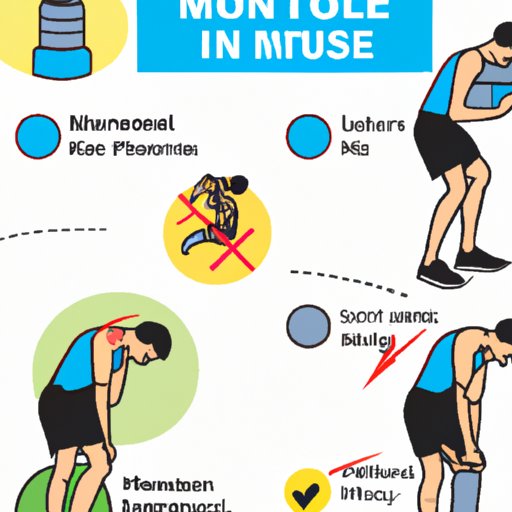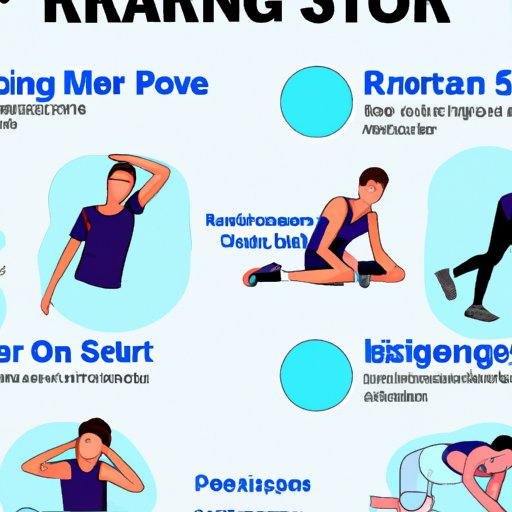Introduction
Muscle soreness is a common issue after exercising, especially if you are new to working out or pushing yourself harder than usual. Soreness can range from mild discomfort to intense pain, but no matter the severity, it’s important to understand what causes it and how to prevent it. In this article, we will explore the causes of muscle soreness after exercise and provide strategies for preventing and managing it.

How to Avoid Muscle Soreness After Exercising
The best way to avoid muscle soreness is to be proactive by taking certain precautions before and after your workout. Here are some tips:
Stretching Before and After Working Out
Stretching before and after working out is essential for maintaining flexibility and preventing injury. Stretching helps to warm up the muscles and increase blood flow, which can reduce the risk of soreness. It also reduces the risk of injury by helping to prepare the body for the physical strain of exercise.
Proper Nutrition for Recovery
Proper nutrition is key for muscle recovery after exercise. Eating a balanced diet with plenty of protein, carbohydrates, and healthy fats can help the muscles rebuild and recover faster. Additionally, anti-inflammatory foods like turmeric and ginger can help reduce inflammation and soreness in the muscles.
Adequate Rest
Getting enough rest is essential for muscle recovery. Muscles need time to repair themselves after exercise, so getting 7-9 hours of sleep per night can help ensure that your muscles have the time they need to recover and rebuild. Additionally, taking breaks between workouts can give your body time to rest and recover.

What Causes Muscle Soreness and How to Prevent It
There are several factors that can contribute to muscle soreness after exercise, such as intensity and duration of exercise, dehydration, lack of a warm-up, and overuse of muscles. Here are some tips for preventing muscle soreness:
Intensity and Duration of Exercise
The intensity and duration of your workout can have an impact on muscle soreness. If you are new to exercise or pushing yourself too hard, you may experience more soreness than usual. To prevent this, try to start slowly and gradually increase the intensity and duration of your workouts.
Dehydration
Dehydration can cause muscle fatigue, cramping, and soreness. Make sure to drink plenty of water before, during, and after your workout to stay hydrated. Additionally, eating foods with high water content, such as fruits and vegetables, can help keep your body hydrated.
Lack of Warm-up
A warm-up is essential for preparing the body for exercise and reducing the risk of injury. A good warm-up should include dynamic stretching, light cardio, and activating the muscles you will be using in your workout. This will help to get the blood flowing and reduce the risk of soreness.
Overuse of Muscles
If you push yourself too hard or use the same muscles too often without allowing them time to rest and recover, you may experience soreness. To prevent this, make sure to switch up your exercises and give your muscles time to rest in between workouts.
The Benefits of Stretching Before and After Working Out
Stretching is one of the best ways to prevent muscle soreness after exercise. Here are some of the benefits of stretching before and after your workout:
Improved Flexibility
Stretching helps to increase flexibility in the muscles, which can improve performance and reduce the risk of injury. Stretching regularly can also help to maintain good posture and reduce tension in the muscles.
Reduced Risk of Injury
Stretching helps to increase blood flow to the muscles, which can reduce the risk of injury. It also helps to lubricate the joints and improve range of motion, which can reduce the risk of strains and tears.
Improved Performance
Stretching can help to improve performance by increasing flexibility and range of motion. It can also help to reduce fatigue and improve coordination, which can lead to better results in your workouts.
What You Should Know About Delayed Onset Muscle Soreness (DOMS)
Delayed Onset Muscle Soreness (DOMS) is a type of muscle soreness that occurs 24-48 hours after exercise. Here is what you should know about DOMS:
Symptoms
The symptoms of DOMS include muscle stiffness, swelling, tenderness, and pain. These symptoms usually peak 24-48 hours after exercise and can last for up to 72 hours.
Causes
The exact cause of DOMS is not known, but it is believed to be caused by microscopic tearing of the muscle fibers. This can result from overexertion or sudden movements that the muscles are not used to.
Treatment
Treating DOMS typically involves using strategies to reduce inflammation, such as rest, ice, compression, and elevation. Over-the-counter medications, such as ibuprofen, can also be used to reduce pain and swelling.
The Benefits of Proper Nutrition for Recovery After Exercise
Proper nutrition is essential for muscle recovery after exercise. Here are some of the benefits of proper nutrition for recovery:
Protein and Carbohydrates
Consuming adequate amounts of protein and carbohydrates after exercise can help the muscles rebuild and recover. Protein helps to repair and rebuild muscle tissue, while carbohydrates provide energy for the body to use during recovery.
Anti-inflammatory Foods
Eating anti-inflammatory foods, such as turmeric, ginger, and omega-3 fatty acids, can help reduce inflammation and soreness in the muscles. These foods can also help to reduce swelling and speed up recovery time.
Hydration
Staying hydrated is essential for muscle recovery. Drinking plenty of water before, during, and after your workout can help to flush out toxins, reduce inflammation, and replenish lost fluids.

Strategies for Managing Soreness After Exercise
In addition to proper nutrition and adequate rest, there are several strategies for managing soreness after exercise. These include massage, ice baths, compression clothing, and sleep.
Massage
Massage can help to reduce muscle tension and improve blood flow. This can help to reduce soreness and improve recovery time. Massage can also help to reduce stress and promote relaxation.
Ice Baths
Taking an ice bath after exercise can help to reduce inflammation and soreness in the muscles. Ice baths can also help to reduce swelling and speed up recovery time.
Compression Clothing
Compression clothing can help to reduce soreness by providing support to the muscles and improving circulation. It can also help to reduce swelling and improve recovery time.
Sleep
Getting enough sleep is essential for muscle recovery and repairing damaged muscle tissue. Aim for 7-9 hours of sleep per night to give your body the time it needs to recover and rebuild.
Conclusion
Muscle soreness is a common problem after exercise, but it can be prevented and managed with the right strategies. Stretching before and after your workout, proper nutrition for recovery, adequate rest, and other strategies can help to reduce soreness and improve recovery time. Remember to listen to your body and take breaks when needed to ensure that your muscles have the time they need to recover and rebuild.
(Note: Is this article not meeting your expectations? Do you have knowledge or insights to share? Unlock new opportunities and expand your reach by joining our authors team. Click Registration to join us and share your expertise with our readers.)
